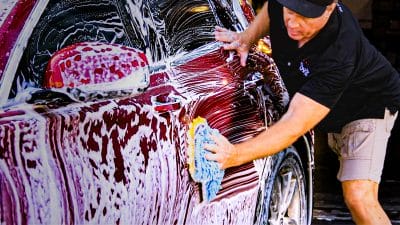Last Updated April 29, 2022
Paintwork protection tech is outpacing correction tech in 2020. If you take a look at today’s ceramic nanocoatings and stack them up against most polishes, it’s hard not to come away with that impression. But there is a new priming technology coming this month that’s set to bring surface correction into the ceramic nano age. They’re called “Nano Surface Primers” and they utilize a new Dr. Beasley’s technology called “DxPrime”. But to explain DxPrime best, it helps to take a look at what was holding polish technology back in the first place. So ahead we’ll break the biggest issues down in terms of organic residuals, ability to prep for ceramic nanocoatings, cut precision and overall shine quality. Let’s get into it now.
Imprecise Cuts
All polishes and compounds cut through the clear coat using abrasives suspended within a base substance. They typically employ one of two abrasive technologies—diminishing abrasive technology (DAT) or super micro abrasive technology (SMAT). DAT abrasives break down as you buff, preventing you from cutting too deeply into the clear coat. SMAT, on the other hand, will not break down, so how deeply you want to cut is up to you.
These two technologies, however, have a serious drawback: abrasive size variance. SMAT and DAT abrasives vary widely in size, and when you’re talking tiny abrasives, just a few microns can make a difference. With imprecise size comes imprecise cut. In an industry that values exacting precision, this is unacceptable.
Organic Residuals
Many polishes and compounds have bases rife with organic substances such as wax and silicone oils. Waxes are there to fill in remaining imperfections, while silicone oils lubricate the pad for optimal mobility. Through the process of buffing, these substances smear onto the paint and become difficult to remove. That’s a big problem if you want to apply a coating.
Ceramic nanocoatings physically bond with their substrates, fusing to become an extension of the surface. Because of that, they’re only as durable as the surface they’re bonded to. If the surface degrades, so does the coating. So to get optimal durability, a nanocoating must bond with a surface that is inorganic and won’t degrade, like a clear coat.
But if you have a surface riddled with organic residuals, the coating won’t bond to the clear coat. Instead, it’ll be bonding to the residuals, and when those residuals degrade (as all organic substances do) the coating bond will be gone entirely. This is why detailers take such pains to remove organic residuals with IPA and other specialized cleaning solutions before applying a coating.
Uneven Abrasive Distribution
To evenly cut through the clear coat, abrasives suspended in the polish or compound base must be distributed evenly. Typically polish and compound bases are creamy in viscosity, which doesn’t suspend abrasives well. Instead, they sink to the bottom and accumulate. That’s why people shake their polish bottles thoroughly before dispensing onto the pad. But even if you shake as hard as you can, those abrasives are still going to sink, increasing the chance of particle accumulation and therefore an uneven cut.
Deceptive & Short-Lived Shine
As you may recall earlier, we discussed how polish and compound bases often use organic fillers and oils that remain as residue after the correction step is completed. These fillers are there to smooth things over by covering up any remaining imperfections in the surface, thereby offering more dramatic results. These results don’t last long, however. Because these fillers are organic, they end up degrading pretty quickly, revealing a less-than-perfect finish with a dull appearance. Thinking you’ve gotten an amazing shine only to see it turn to “meh” in a couple weeks is disheartening at best and infuriating at worst.
Disrupts Nanocoating Workflow
In theory, the nanocoating application process should look like this: Wash -> Decontamination -> Correction -> Protection. But in practice, dated polish technology throws a wrench into the workflow. Because of the organic residue left behind, extra steps are required to not only remove the residue, but to prime the surface as well. This is why so many ceramic nanocoatings come with prep sprays and base coat sprays. And it’s this inefficiency that brings us to our final question: why is polish technology so out of date?
Most Polishes Aren’t Designed For Ceramic Nanocoatings
As much as we’d like to believe detailing has fully entered the 21st century, it’s still a fundamentally conservative industry when it comes to technology. The latest innovation, micro abrasives, had actually been around for decades in other sectors before SMAT came to the detailing industry in the early-mid 00’s. So what’s holding back innovation with polishes? It all has to do with what polishes are and aren’t designed for.
When polishes and compounds are being developed, engineers are designing with the end user in mind. They have to think about how the average person will use a polish. And what will the average user be protecting with after buffing? A wax or sealant. Suddenly, all of the drawbacks polishes have start to make sense. Organic residuals may not play well with a nanocoating, but they work fine with most waxes and sealants. Imprecise cuts may look terrible under a clear nanocoating, but with a filling wax there’s more room for error. So at the end of the day, most polishes just aren’t made for nanocoatings!
Engineering a Nano Surface Primer
With many polishes still relying on outdated technology, you start to wonder if anyone is trying to fix this. Well, as we mentioned earlier, Dr. Beasley’s has developed a proprietary “DxPrime” technology that actually preps the surface for coating during the correction step.





Questions? Comments?
Email Us